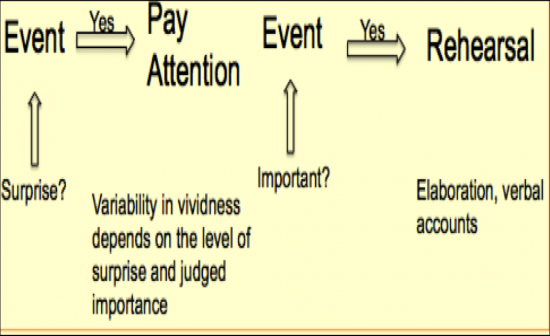Cards In This Set
| Front | Back |
|
Memory
|
-intuitive mechanism. Study of how we encode, retrieve, and retain past information and remember future events. It is also a study of how we forget
-Hermann Ebbinghaus (1885)-put memory on the map as experimental area |
|
Memorizing meaningless novel stimuli
|
Varied
1. List length 2. Retention interval 3. Type of memorization method |
|
Facts about memory
|
§ Memory can be studied experimentally
§ Difficulty varies disproportionately with list length § Amount of retention depends on the degree of initial learning (levels of processing) § Retention is better if studying is distributed |
|
Memory Metaphors
|
O We can store, search, organize, recollect information.
o Plato Aristotle-Wax Tablet o Freud & James- House. Spatial aspect, a house with its rooms, repressed memories in the basement current memories in first floor future plans in the attic o Freud-Mystic writing pad- a model of memory based on a children’s toy writing tablet that allows new messages to be written on one level, while fragments of old messages accumulate on another level. o Reappearance hypothesis: the hypothesis that memory is a re-experiencing of the past o Library-place where things are stored. Categorized in index cards, you have to know what you’re looking for by subject or key words, find the corresponding card which will give you its information its number and where its located o Conveyor belt- magically appears when you need it, suitcase hasn’t been opened and appears on this belt |
|
Memory traces
|
Physical memory trace in the brain. When we learn the brain changes, theres imprint of what we learn. This trace might have changed over and over given to retrieval context
|
|
Memory schema
|
How we recall a particular event. Organized way in which we recall information which may show biases to original memory trace.
|
|
Schema
|
Organized setting that guides our behavior and changes with circumstance. We know what to expect E.g. supermarket, club, class
|
|
Consolidation of memories
|
The time between learning and remembering
|
|
Reconsolidation of memories
|
Time bw recall and remembering again
|
|
Fragility of memory traces
|
Easily changed
|
|
Flashbulb memories
|
 · highly unexpected. Vivid, detailed memories of extraordinary events. Special and unique type of memory. E.g. everyone remembers what they were doing and where they were when they found out about the twin towers |
|
Flashbulb memory reports contain info in 5 categories
|
1. the place in which they were when they learned of the assassination
2. what they were doing when they were interrupted by the news of the assassination 3. the person who was their informant 4. affect-how they felt at the time 5. the aftermath |
|
Now Print Theory
|
Adapted from work of Livingstone. The theory that a specific process, similar to xerography, lays down in memory copies of especially significant experiences.
|
|
McCloskey et al (Flashbulb)
|
-Compared narrative accounts 3 days and 9 months after Challenger’s explosion
-Found considerable loss of detail in flashbulb memory over time, after nine months less detail, more general -Inaccuracies introduced when information that cant be retrieved from memory is filled in through inference -“Flashbulbs memories are places where we line up our own lives with the course of history and say ‘I was there’” Neisser |
|
Talarico and Rubin (Flashbulb)
|
-Investigated accuracy of memories of 9/11 as well as regular memories
- Both types of memories led to loss of information over time - However, people are more CONFIDENT in the accuracy of flashbulb memories |



